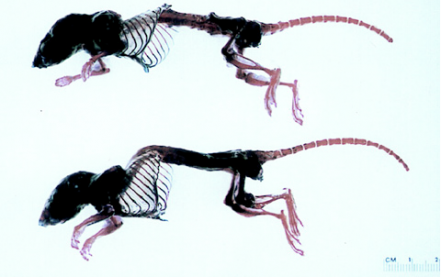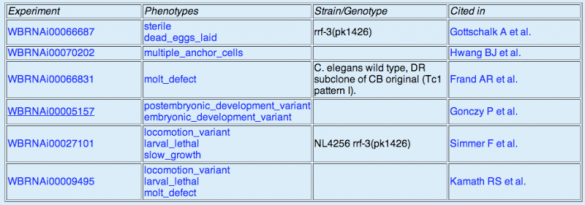This web page was produced as an assignment for Genetics 677, an Undergraduate course at UW-Madison
RNAi and C. elegans
Using Phenobank, a homolog of FBN-1 was found in C. elegans by searching for the gene. A similar protein of FBN-1 activity exists in the worm model organism, which is required for completion of molting. Gene ontology terms for ZK783.1 are Calcium ion binding, proteolysis and peptidolysis, and trypin. The human gene shares the Calcium ion binding GO term, but lacks the others. Please click on the Gene Ontology link for more information. Upon searching WornBase for ZK783.1, a paralog was found, mua-3. This indicates a gene product that was formed by duplication within the genome and evolved to perform a different function. In terms of homology and phylogeny, ZK783.1 is divergent on the tree of the FBN family when compared to Human FBN genes. This could theoretically be due to a single gene responsible for this activity in C. elegans, which evolved into two separate genes in Humans, FBN1 and FBN2. This tree can be seen in the Phylogeny portion of this website. (1)
RNAi phenotypes were identified through various experiments. Observed phenotypes when RNA was knocked down include sterile, dead eggs laid, multiple anchor cells, molt defect, locomotion variant, larval lethal, slow growth, and (post) embryonic development variant. There were some phenotypes not observed through other experiments that overlap such as maternal sterile. (2)
RNAi and Drosophila melanogaster
No homologs of FBN1 were found in Drosophila melanogaster when searching the FLYBASE database. (3)
Analysis
The primer used in these experiments was Sjj_zk783.2. I would probably use that same primer in any experiment I would like to perform myself in C. elegans. However, there are more similar homologs in other model organisms, and research using RNAi in those organisms would be more beneficial when applying research to humans. I would use the mouse model to study mutations in FBN1 because there is a greater percent max identity to humans. Also, the qualitative observations of bone and tissue structure are more visible in mice as you can see in in the picture below. The upper mouse has wild type FBN1 and the lower mouse has a mutation in its FBN1 gene. Increased bone growth is observed in the ribs, vertebral column, and tail.
1856230

Mutant fibrillin mouse phenotype (4)
References
(1) Phenobank http://www.worm.mpi-cbg.de/phenobank2/cgi-bin/MenuPage.py
(2) Wormbase http://www.wormbase.org/
(3) Flybase http://flybase.org/
(4) MGI http://www.informatics.jax.org/
(2) Wormbase http://www.wormbase.org/
(3) Flybase http://flybase.org/
(4) MGI http://www.informatics.jax.org/
Gabrielle Waclawik
[email protected]
May 13, 2010
www.gen677.weebly.com
[email protected]
May 13, 2010
www.gen677.weebly.com

